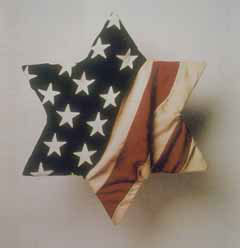The Star
Artist: Roger Cook (U.S.)
Dimensions: 16” x 20”
1993
The Star is a stunningly psychological poster that ignites a chain reaction of questions about organized Zionism and its impact on the United States.
The stars on the American flag are five-pointed; here, an American flag is wrapped around the six-pointed Magen David (Hebrew: Star of David), the national political emblem of modern Israel as well as the iconic symbol of Zionism. The Star is boldly set out against a white background with no accompanying text, thereby deliberately focusing the viewer’s attention on the artist’s provocative premise.

With this poster, designer Roger Cook ascends
from the pack of politically timid American artists to challenge a taboo.
Though Israeli and Jewish poster artists regularly treat the Magen
David with the same high degree of political irreverence that American
artists show for the Stars and Stripes, until Cook the Magen
David had been treated as off-limits by American artists.
Cook fuses the U.S. flag and the Star of David to make a political declaration:
that Zionism is a significant internal force in American political
life, capable of morphing it into a new and alien shape. The poster challenges
Americans to review the assumptions that have allowed Zionism to flourish
without question or restraint.
Some view The Star as patently anti-Semitic. This is an egregiously under-informed response. This thoughtful, seminal poster has absolutely nothing in common with the paranoid, artless drivel produced by domestic lumpen anti-Semitism. It belongs to a diametrically different genre, that of the principled, historically legitimated arts of the contemporary American left, such as that which blossomed out of the Berkeley Free Speech Movement of the mid-1960s and the anti-Vietnam war movement, for example.
Posters like this are subject to criticism from the hasbara (Hebrew: Israel advocacy, solidarity) movement on the grounds that it only presents one side. Yet this is political art; it takes a stand. It is not the intent or the responsibility of a political artist to provide balance within the context of a single work. Artists with opposing views are free, indeed welcome, to respond to The Star with their own publicly-shared art; balance results from interplay, not from a single poster.
Posters like this have been condemned on the grounds that they only criticize Israel. The hasbara argument is that the violations of human and political rights in Chechnya, Burma, South Africa, and a host of other places represent far worse examples of oppression than those found in the Occupied Territories; therefore, so the hasbara argument goes, the focus of criticism on Israel amounts to anti-Semitism.
However, the carnage and destruction in Chechnya reflects on the morality
of the Russian government and people, not on the United States. The oppression
of the people of Burma is a reflection on the Burmese junta, not on the
United States. Post-apartheid South Africa has many problems, but ordinary
Americans have no hand in creating them. Because of the immense political
and financial involvement of the U.S. in building and maintaining Israel,
that country’s actions do reflect on the moral character
of Americans. Israel advocacy cannot have it both ways: it cannot claim
a special relationship the United States and then react with indignation
and charges of anti-Semitism when some Americans, question the particulars
of that relationship.
Perhaps the greatest gift of Cook’s poster is that it asserts the
right of Americans to disassociate from Zionism. In an in-depth series
of articles published by The Washington Post in the early 1980s,
a senior executive of the America-Israel Public Affairs Committee (AIPAC)
said, “Zionism is like a mushroom: it grows best in the dark.”
With this poster, Cook makes the argument for light.
© 2003 Liberation Graphics. All Rights Reserved.Questions for A New
Democratic Discussion
1) Is this poster acceptable political commentary, or is it anti-Semitic vitriol? Defend your position. If you consider it to be anti-Semitic, how could an American artist represent opposition to Zionism without generating the charge of anti-Semitism? What language and symbols, specifically, could be employed to make the same arguments Cook is making without running afoul of hasbara criticisms?
2) Would this graphic be controversial if the poster carried the caption, “Fifty-Five Years of U.S.-Israel Solidarity and Cooperation”? If yes, why? If no, why not?
3) What are the major iconographic symbols in the Palestinian-Israeli conflict? Are any of these symbols off-limits, and if so, where and why? Who sets the proscriptions?
4) Consider the following incident: In a 2003 debate among the Democratic Party candidates running for U.S. president, former Vermont Governor Howard Dean said, “There is a war going on in the Middle East, and members of Hamas are soldiers in that war, and, therefore, it seems to me that they are going to be casualties if they are going to make war.” Another candidate, Senator Joseph Lieberman, of Connecticut, criticized Dean’s use of the term “soldiers” to describe members of Hamas and said that Dean was naïve about Middle East politics. What words are off-limits in this political debate, and why? What does it say about the state of the language that a presidential candidate was not able to make word choices related to U.S. Middle East policy acceptable to other presidential candidates? What does Sen. Lieberman mean by “naïve”? What does he know, that others should know, so that they will not be accused of naïvete?
Please send us your questions and comments (English only please!)
www.liberationgraphics.com